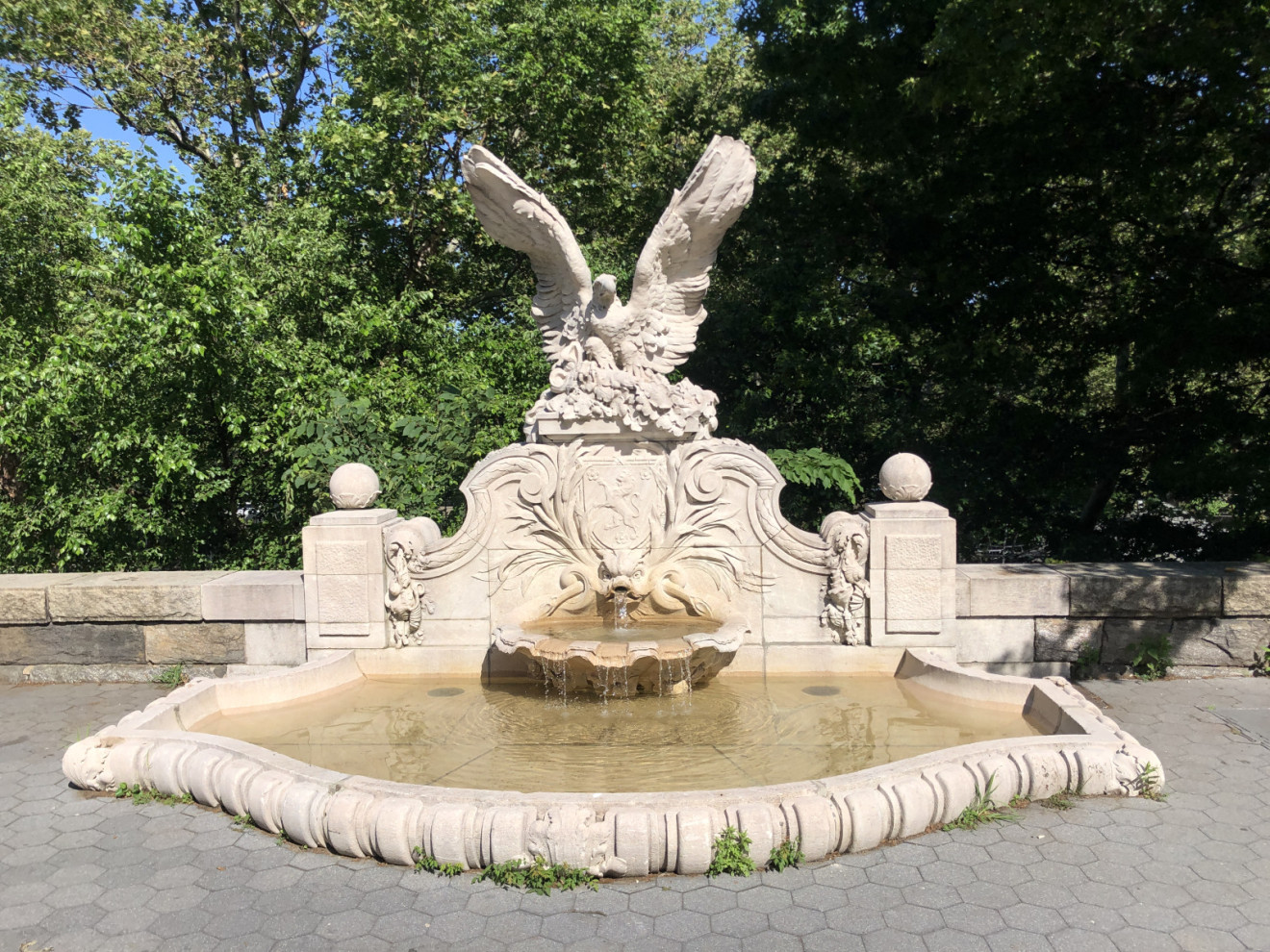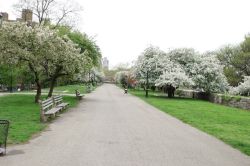Riverside Park
View all monuments in NYC Parks, as well as temporary public art installations on our NYC Public Art Map and Guide.
Robert Ray Hamilton Fountain
| Dedicated: | 1906 |
| Location: | Riverside Drive at West 76th Street |
Artwork History
This ornate, baroque-styled marble fountain is named for Robert Ray Hamilton (1851-1890) a prominent businessman, landowner and politician who bequeathed $9,000 to the City for its creation and installation. It is one of the finest and last surviving examples of the decorative horse troughs that once dotted the cityscape.
Hamilton, a great-grandson of statesman Alexander Hamilton, was educated at Columbia Grammar School, College, and Law School. He owed his wealth to properties he owned on the west side of Manhattan, as well as an inheritance that yielded him an annual income of $40,000—a sizable sum at the time. Though defeated when he ran in 1879 for a seat on the Board of Alderman, the following year he was elected to the State Assembly, from the Eleventh District, subsequently defeated and then reelected to several terms from 1885 to 1889.
After Hamilton’s death, executors of his estate and the City retained the esteemed architectural firm of Warren & Wetmore—whose more notable buildings include Grand Central Terminal, Chelsea Piers, and the Con Edison Tower—to design the fountain. An initial rendering, more limited in scope, was rejected by the City’s Art Commission before the present design with its central eagle feature was approved and realized.
Crafted from Tennessee marble, the lavishly carved fountain, composed of separate masonry units, is surmounted by an eagle with wings spread, beneath which are decorative motifs, a coat of arms, a dolphins’ head spray feature, a shell-shaped spill basin, and a larger foliate catch basin. There is an upward-facing incised commemorative inscription, worn by time, on the front perimeter of the basin. The fountain stands at the center of a sidewalk plaza and is inserted into the 19th-century rustic retaining wall of the earliest portions of Riverside Park.
Created for “man and beast,” the fountain was evidently intended primarily as a drinking fountain for horses, and was erected during an era when the streets of Manhattan were frequented by thousands of horses on a daily basis, and equine transport was the principal means of conveying goods and people around the city. To satisfy the horses’ thirst, numerous watering fountains and troughs were installed along the city’s streets. Many were erected by humane societies such as the American Society for the Prevention of Cruelty to Animals (ASPCA). In addition to fulfilling a necessary function of preserving the health of beasts of burden, these roadside fountains often exhibited a great degree of artistry in their design and ornamentation.
The decline of horse-drawn commercial vehicles resulted in the virtual elimination of these fountains by World War II. While the Hamilton Fountain survived, it fell into disrepair, was vandalized, and its plumbing ceased to function. For a period, neighborhood volunteers maintained aquatic plants in the still water of the basin, and even koi swam here. In 2009 private donations to the Riverside Park Conservancy made possible the restoration of the fountain, including conservation of the ornamentation, installation of new electrical and plumbing service, repaving of the plaza with hexagonal blocks, and planting four serviceberry trees. The Riverside Park Conservancy has also established a maintenance fund to provide for the ongoing care of this significant historic monument.
Artwork Details
| Description: | Fountain, topped with eagle |
| Architect: | Warren and Wetmore |
| Materials: | Tennessee marble |
| Dimensions: | H: 11'5" W: 17'5" D: 10'2" |
| Donor: | Robert Ray Hamilton, by bequest |
| Cast: | Circa 1906 |
Inscription
BEQUEATHED TO THE CITY OF NEW YORK BY / ROBERT RAY HAMILTONPlease note, the NAME field includes a primary designation as well as alternate namingsoften in common or popular usage. The DEDICATED field refers to the most recent dedication, most often, butnot necessarily the original dedication date. If the monument did not have a formal dedication, the yearlisted reflects the date of installation.
For more information, please contact Art & Antiquities at (212) 360-8163.
Check out your park's Vital Signs
Clean & Safe
Green & Resilient
Empowered & Engaged Users
Share your feedback or learn more about how this park is part of a
Vital Park System

Know Before You Go
Due to construction, as of September 23, 2024, Cherry Walk at Riverside Park is temporarily closed between West 100th Street and St. Clair Place (West 125th St). Please view our Temporary Greenway Detour map for an alternative route.
Anticipated Completion: Spring 2025
Related inquiries may be sent to boatbasin@parks.nyc.gov
Related inquiries may be sent to boatbasin@parks.nyc.gov



